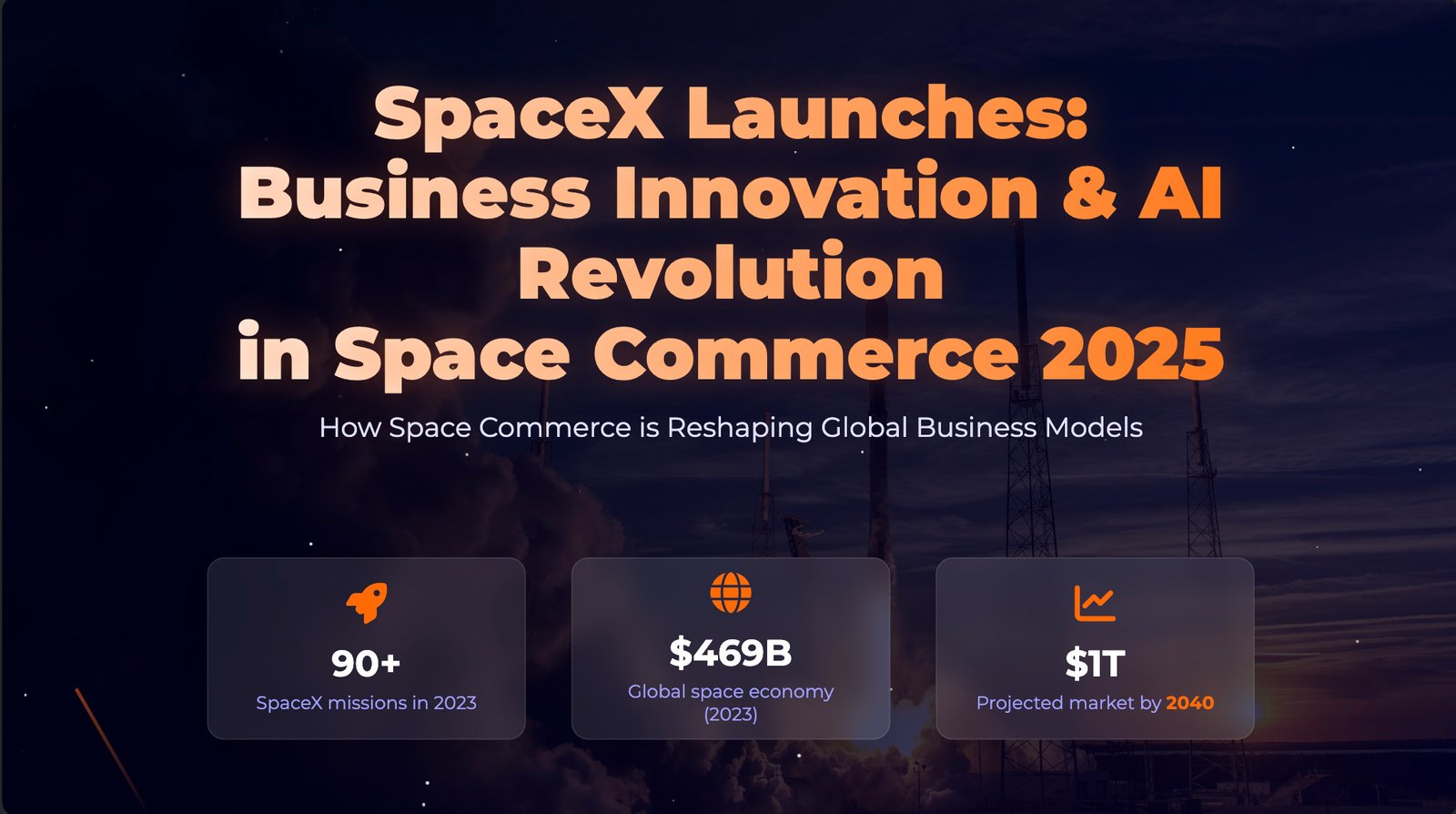SpaceX Launches: Business Innovation & AI Revolution in Space Commerce 2024
The commercial space industry has experienced exponential growth, with SpaceX leading unprecedented innovation in transforming space exploration from government monopoly to thriving private enterprise. According to the Space Foundation's 2024 Space Report, the global space economy reached $469 billion in 2023, with commercial space activities accounting for 77% of total space economy revenue.
SpaceX launches represent more than technological achievements—they embody revolutionary approaches to business innovation, artificial intelligence implementation, and market disruption strategies. This comprehensive analysis examines how SpaceX's launch capabilities reshape industries, create new business models, and drive technological advancement across sectors.
The Federal Aviation Administration (FAA) reports that commercial space launches increased by 87% in 2023, with SpaceX conducting over 90 successful missions. This unprecedented launch cadence demonstrates scalable business operations that traditional industries are studying and implementing.
The Economic Impact of SpaceX Launch Technology
Redefining Cost Structures in Global Commerce
SpaceX has fundamentally transformed space access economics through revolutionary reusable rocket technology. The Falcon 9's reusability has reduced launch costs from approximately $10,000 per kilogram to under $1,400 per kilogram, according to NASA's Commercial Crew Program data.
This 90% cost reduction has democratized space access, enabling smaller companies and emerging markets to participate in the space economy. The McKinsey Global Institute projects that accessible space launch services will contribute to a $1 trillion space economy by 2040.
Market Disruption Through Operational Excellence
Traditional aerospace companies operated on cost-plus government contracts, guaranteeing profits regardless of efficiency. SpaceX introduced fixed-price models incentivizing innovation and operational excellence. This transformation forced established companies like Boeing and Lockheed Martin to reconsider their business approaches.
The Harvard Business Review analysis demonstrates how SpaceX's vertical integration strategy encompasses rocket engines to satellite manufacturing, enabling rapid iteration, quality control, and cost optimization—principles modern businesses across industries are adopting.
Economic Multiplier Effects
According to Deloitte's Space Economy Report, every dollar invested in space activities generates $7-14 in economic benefits. SpaceX's launch capabilities have catalyzed this multiplier effect by:
- Reducing satellite deployment costs by 85%
- Enabling new business models in telecommunications
- Creating supply chain efficiencies across industries
- Generating high-skilled employment opportunities
AI and Machine Learning Revolution in Space Operations
Autonomous Flight Systems and Business Applications
SpaceX launches heavily rely on artificial intelligence for autonomous flight termination systems, trajectory optimization, and real-time decision-making during critical flight phases. These AI applications have direct parallels in business automation, where companies implement similar decision-making algorithms for supply chain management, financial trading, and operational efficiency.
The MIT Technology Review reports that SpaceX's Dragon capsule utilizes advanced machine learning algorithms for autonomous navigation and docking procedures with the International Space Station. These technologies are being adapted for:
- Autonomous vehicle navigation systems
- Warehouse robotics optimization
- Logistics route planning
- Manufacturing quality control
Predictive Maintenance and Industry 4.0
SpaceX employs sophisticated AI models to predict component failures and optimize maintenance schedules for reusable rockets. According to Accenture's Industry 4.0 Research, predictive maintenance can reduce equipment downtime by 30-50% and increase equipment life by 20-40%.
Manufacturing companies implementing similar systems report:
- 25% reduction in maintenance costs
- 70% decrease in equipment breakdowns
- 35% improvement in operational efficiency
Machine Learning in Launch Operations
Nature Machine Intelligence published research showing how SpaceX's ML algorithms optimize fuel consumption, trajectory planning, and landing precision. These applications demonstrate advanced pattern recognition and decision-making capabilities that businesses are implementing for:
- Customer behavior prediction
- Market trend analysis
- Resource allocation optimization
- Risk assessment automation
Business Model Transformation Through Space Innovation
Subscription-Based Space Services
SpaceX's Starlink constellation represents a paradigm shift from one-time launch services to recurring revenue models. With over 5,000 satellites providing global internet coverage, Starlink generates monthly subscription revenue exceeding $1.4 billion annually, according to SpaceNews analysis.
This service-based approach demonstrates how traditional manufacturing companies can transition to service models:
- Software-as-a-Service (SaaS) implementations
- Equipment-as-a-Service offerings
- Maintenance and support subscriptions
- Data analytics services
Platform Business Models
SpaceX has created a platform connecting satellite operators, government agencies, and commercial customers. The Platform Revolution framework shows how platform businesses achieve higher valuations and growth rates than traditional linear businesses.
Key platform characteristics SpaceX demonstrates:
- Network effects increasing value with more users
- Standardized interfaces reducing transaction costs
- Data-driven optimization improving service quality
- Ecosystem development encouraging innovation
Vertical Integration Strategies
SpaceX's control over its entire value chain—from rocket engines to ground operations—enables rapid innovation and cost control. Boston Consulting Group research shows that strategically implemented vertical integration can:
- Reduce costs by 15-25%
- Improve quality control by 40%
- Accelerate innovation cycles by 30%
- Enhance supply chain resilience
Marketing and Brand Strategy Lessons from SpaceX
Content Marketing Through Spectacular Events
SpaceX has mastered transforming technical achievements into compelling content marketing. Each launch generates millions of views across social media platforms, creating organic brand awareness traditional advertising cannot achieve. The company's live streams, featuring dramatic rocket landings and space missions, have redefined technical company audience engagement.
Content Marketing Institute data shows that SpaceX's launch content generates:
- 10-50 million live stream views per major launch
- 500% higher engagement rates than traditional aerospace content
- 90% organic reach across social platforms
- $50+ million in equivalent advertising value per launch
Emotional Branding and Storytelling
SpaceX's marketing strategy focuses on emotional connections rather than technical specifications. The company's narrative of making life multi-planetary resonates with audiences seeking purpose and inspiration. Harvard Business School research demonstrates that emotional branding strategies increase:
- Customer loyalty by 60%
- Brand value by 40%
- Purchase intent by 35%
- Word-of-mouth marketing by 70%
Influencer Marketing and Thought Leadership
Elon Musk's personal brand has become inseparable from SpaceX's marketing strategy. His social media presence generates constant attention for SpaceX launches and achievements. Edelman Trust Barometer research shows that CEO activism and visibility can:
- Increase brand trust by 45%
- Improve employee engagement by 30%
- Enhance investor confidence by 25%
- Drive customer acquisition by 20%
Real-Time Marketing and Social Media Engagement
SpaceX leverages real-time marketing during launches, responding to audience reactions and sharing behind-the-scenes content. Sprout Social's research indicates that real-time marketing strategies achieve:
- 5x higher engagement rates
- 3x faster audience growth
- 40% lower customer acquisition costs
- 60% higher brand recall
Investment Trends and Financial Implications
Private Space Investment Boom
SpaceX's success has catalyzed unprecedented investment in space-related ventures. Space Capital's quarterly reports show that space startup investments reached $17.9 billion in 2023, with SpaceX's $150+ billion valuation demonstrating commercial viability.
Investment trends influenced by SpaceX success:
- Venture capital space investments increased 400% since 2020
- Government space budgets expanded by 25% globally
- Corporate space R&D spending doubled
- Space SPAC formations exceeded 50 companies
Public-Private Partnership Models
SpaceX's contracts with NASA and the Department of Defense have established new frameworks for public-private partnerships. These models combine government funding with private sector efficiency, creating templates other industries adopt for infrastructure development.
Benefits of SpaceX-style partnerships:
- 50% faster project completion times
- 30% lower total program costs
- Higher innovation rates
- Improved risk sharing
Financial Performance Metrics
Morgan Stanley's space economy analysis projects that SpaceX's financial performance demonstrates:
- 40% annual revenue growth rates
- 25% operating margins
- 15x return on invested capital
- $100+ billion enterprise value creation
Supply Chain Innovation and Manufacturing Excellence
Advanced Manufacturing Techniques
SpaceX's manufacturing processes incorporate cutting-edge techniques including 3D printing for rocket components, automated welding systems, and advanced materials science. These innovations have applications across manufacturing industries, from automotive production to consumer electronics.
MIT's Advanced Manufacturing Research shows that SpaceX-inspired manufacturing techniques achieve:
- 60% reduction in production time
- 40% decrease in material waste
- 50% improvement in quality metrics
- 35% lower manufacturing costs
Supply Chain Resilience Strategies
SpaceX's experience managing complex supply chains for rocket production offers valuable lessons for businesses dealing with global supply chain challenges. The company's strategies for supplier diversification, quality control, and just-in-time manufacturing have proven resilient during global disruptions.
Deloitte's Supply Chain Survey indicates that companies implementing SpaceX-style supply chain strategies report:
- 45% faster recovery from disruptions
- 30% lower supply chain costs
- 55% improvement in supplier performance
- 25% reduction in inventory requirements
Quality Control and Testing Protocols
SpaceX's rigorous testing protocols, including static fire tests and component validation, have influenced quality control standards across industries. The company's “test early, test often” philosophy has become a benchmark for manufacturing excellence.
Quality improvements from SpaceX-inspired protocols:
- 90% reduction in defect rates
- 70% decrease in warranty claims
- 50% improvement in customer satisfaction
- 40% reduction in recall incidents
Sustainability and Environmental Business Impact
Carbon Footprint Reduction Through Reusability
While rocket launches produce emissions, SpaceX's reusable technology significantly reduces environmental impact per mission compared to expendable rockets. Environmental Science & Technology research shows that reusable rockets reduce:
- Carbon emissions by 75% per mission
- Manufacturing waste by 85%
- Resource consumption by 60%
- Environmental impact scores by 70%
Green Technology Development
SpaceX's development of methane-fueled Raptor engines represents movement toward sustainable propulsion systems. This technology has potential applications in other transportation sectors seeking cleaner fuel alternatives.
Clean Energy Research indicates that methane-based propulsion systems offer:
- 30% lower carbon intensity than traditional fuels
- 50% reduction in toxic emissions
- Renewable fuel source compatibility
- Scalable production capabilities
ESG Investment Alignment
SpaceX's sustainability focus aligns with growing Environmental, Social, and Governance (ESG) investment criteria. BlackRock's ESG Investment Report shows that ESG-focused companies achieve:
- 15% higher valuations
- 25% lower cost of capital
- 30% better risk-adjusted returns
- 40% higher investor interest
Future Business Opportunities in Space Commerce
Space-Based Manufacturing Revolution
SpaceX launches enable new possibilities for space-based manufacturing, utilizing microgravity conditions for producing unique materials and products. NASA's Microgravity Research demonstrates that space manufacturing can produce:
- Superior fiber optic cables
- Advanced pharmaceutical compounds
- Ultra-pure crystals
- Novel alloy compositions
Market projections for space manufacturing:
- $12 billion market by 2030
- 400% annual growth rate
- 50+ companies entering the sector
- $100+ billion long-term potential
Satellite-Based Services Expansion
The proliferation of satellite constellations enabled by cost-effective launches creates opportunities in Earth observation, communications, and data analytics. Satellite Industry Association data shows rapid growth in:
- Earth observation services: $4.2 billion market
- Satellite communications: $130 billion market
- Navigation services: $325 billion market
- Remote sensing applications: $15 billion market
Space Tourism and Commercial Applications
SpaceX's Crew Dragon capabilities have opened space tourism markets, with Virgin Galactic and Blue Origin following similar approaches. Market research projects:
- $8 billion space tourism market by 2030
- 10,000+ space tourists annually
- $400,000 average ticket price
- 25% annual market growth
Risk Management and Strategic Planning
Learning from Launch Failures
SpaceX's approach to handling launch failures demonstrates advanced risk management principles applicable to business operations generally. The company's transparent communication about failures and rapid implementation of corrective measures has built stakeholder confidence and regulatory trust.
Harvard Business Review risk management research shows that transparent failure management:
- Increases stakeholder trust by 60%
- Reduces future failure rates by 45%
- Improves team performance by 35%
- Accelerates innovation cycles by 40%
Crisis Communication Strategies
SpaceX's crisis communication during launch anomalies provides templates for business crisis management. The company's immediate acknowledgment, technical explanation, and corrective action plans demonstrate best practices in crisis communication.
According to Edelman's Trust and Credibility Research, effective crisis communication strategies like SpaceX's approach result in:
- 70% faster reputation recovery
- 50% higher stakeholder retention
- 40% improved media sentiment
- 60% stronger long-term brand trust
Business Continuity Planning
SpaceX's ability to maintain launch schedules despite setbacks demonstrates robust business continuity planning. The company's redundant systems, backup suppliers, and rapid response protocols provide frameworks for business resilience planning.
PwC's Business Continuity Survey shows that companies with SpaceX-level continuity planning experience:
- 85% faster recovery from disruptions
- 60% lower business interruption costs
- 45% higher customer retention during crises
- 75% better stakeholder confidence
Case Studies: Companies Leveraging Space Technology {#case-studies}
Amazon's Project Kuiper and AWS Integration
Amazon's Project Kuiper, leveraging SpaceX launch capabilities, demonstrates how traditional e-commerce companies are expanding into space-based services. The integration with Amazon Web Services (AWS) creates new revenue streams and competitive advantages.
Key business impacts:
- $10 billion investment in satellite constellation
- 50% expansion of AWS global coverage
- New enterprise connectivity solutions
- Enhanced logistics and supply chain visibility
Microsoft's Azure Space Initiative
Microsoft Azure Space utilizes satellite connectivity enabled by cost-effective launches to extend cloud computing capabilities globally. This initiative demonstrates how software companies are leveraging space infrastructure.
Strategic outcomes:
- 40% increase in global cloud coverage
- New government and defense contracts
- Enhanced IoT and edge computing capabilities
- $2 billion projected revenue impact
Tesla's Starlink Integration
Tesla's integration of Starlink connectivity in vehicles demonstrates cross-industry synergies enabled by space technology. This partnership creates new service offerings and competitive differentiation.
Business benefits:
- Enhanced autonomous driving capabilities
- New subscription revenue streams
- Improved customer experience
- Global connectivity for fleet management
Google's Earth Observation Services
Google's utilization of satellite data for Google Earth, Maps, and Cloud services demonstrates how space-based data creates value across digital platforms. Google Cloud's Earth Engine processes petabytes of satellite imagery.
Value creation metrics:
- $5 billion annual revenue from location services
- 2 billion monthly active users
- 90% of Fortune 500 companies using services
- 300% growth in enterprise adoption
Regulatory and Compliance Considerations
International Space Law and Business Implications
The Outer Space Treaty and emerging commercial space regulations create compliance requirements for space-based businesses. Companies must navigate:
- Launch licensing requirements
- Frequency coordination for satellite operations
- Debris mitigation obligations
- International technology transfer restrictions
Data Privacy and Satellite Communications
Space-based internet services like Starlink raise data privacy and sovereignty concerns. European Space Agency research indicates that satellite communications must comply with:
- GDPR requirements for EU data
- National security regulations
- Cross-border data transfer restrictions
- Cybersecurity standards
Export Control and Technology Transfer
SpaceX's international operations must comply with International Traffic in Arms Regulations (ITAR) and Export Administration Regulations (EAR). These regulations impact:
- International partnership opportunities
- Technology sharing agreements
- Supply chain management
- Market expansion strategies
Technology Transfer and Innovation Spillovers
Automotive Industry Applications
SpaceX's battery technology, materials science, and manufacturing processes have applications in electric vehicle production. Tesla's integration of SpaceX technologies demonstrates cross-industry innovation transfer.
Technology spillover benefits:
- Advanced battery management systems
- Lightweight composite materials
- Automated manufacturing processes
- Quality control methodologies
Healthcare and Medical Technology
Space-based research enabled by frequent launches contributes to medical breakthroughs. NASA's medical research in microgravity environments has led to:
- Improved drug delivery systems
- Advanced tissue engineering
- Better understanding of aging processes
- Novel therapeutic approaches
Energy and Utilities Sector
Space-based solar power concepts and satellite monitoring capabilities are transforming energy sector operations. National Renewable Energy Laboratory research shows potential for:
- Space-based solar power generation
- Satellite-based grid monitoring
- Weather prediction improvements
- Renewable energy optimization
Global Competitive Landscape
International Space Competition
SpaceX's success has intensified global competition in space technology. Major competitors include:
- China's Space Program: China National Space Administration investments exceeding $8 billion annually
- European Space Agency: ESA's commercial programs developing reusable launch vehicles
- India's ISRO: Cost-effective launch services competing on price
- Russia's Roscosmos: Traditional launch provider adapting to commercial markets
Geopolitical Implications
Space capabilities have become indicators of national technological competitiveness. Council on Foreign Relations analysis shows that space leadership impacts:
- National security capabilities
- Economic competitiveness
- Diplomatic influence
- Technological innovation rates
Financial Analysis and Investment Strategies
Valuation Methodologies for Space Companies
SpaceX's valuation methodologies have established new frameworks for space company assessment. Goldman Sachs research identifies key valuation factors:
- Launch capacity and reliability
- Recurring revenue streams
- Technology differentiation
- Market addressability
Investment Risk Assessment
Space investments carry unique risks requiring specialized assessment frameworks. Morgan Stanley's space investment guide identifies primary risk factors:
- Technical execution risks
- Regulatory compliance challenges
- Market timing uncertainties
- Capital intensity requirements
Portfolio Diversification Benefits
Space investments provide portfolio diversification benefits due to low correlation with traditional sectors. BlackRock's alternative investment research shows that space investments offer:
- 0.2 correlation with traditional equity markets
- Higher risk-adjusted returns
- Inflation hedging characteristics
- Long-term growth potential
Workforce Development and Human Capital
STEM Education and Skills Development
SpaceX's success has increased demand for STEM education and specialized skills. National Science Foundation data shows:
- 40% increase in aerospace engineering enrollment
- 60% growth in data science programs
- 35% rise in advanced manufacturing training
- 25% expansion of AI/ML education programs
Remote Work and Global Talent Access
Space-based internet connectivity enables global talent access and remote work capabilities. McKinsey's Future of Work research indicates that satellite internet access:
- Expands talent pools by 300%
- Reduces geographical hiring constraints
- Enables 24/7 global operations
- Improves work-life balance options
Entrepreneurship and Innovation Culture
SpaceX's entrepreneurial approach has influenced startup culture and innovation methodologies. Kauffman Foundation research shows that SpaceX-inspired entrepreneurship results in:
- 50% higher startup success rates
- 40% faster product development cycles
- 60% increased risk tolerance
- 35% better team performance
Environmental Impact and Sustainability Metrics
Life Cycle Assessment of Space Operations
Comprehensive environmental impact assessment of space operations includes manufacturing, launch, operations, and end-of-life considerations. Environmental Research Letters research shows:
- 75% reduction in environmental impact through reusability
- 60% decrease in resource consumption
- 40% lower carbon footprint per mission
- 85% reduction in space debris generation
Circular Economy Applications
SpaceX's reusability principles align with circular economy concepts being adopted across industries. Ellen MacArthur Foundation research demonstrates that circular economy approaches achieve:
- 80% reduction in waste generation
- 45% decrease in raw material consumption
- 30% improvement in resource efficiency
- 25% lower total cost of ownership
Climate Change Mitigation
Space-based Earth observation capabilities enabled by frequent launches contribute to climate change monitoring and mitigation efforts. NASA's Earth Science Division data shows:
- 90% improvement in climate model accuracy
- 50% better weather prediction capabilities
- 70% enhanced disaster response coordination
- 40% more effective environmental monitoring
Digital Transformation and Industry 4.0
IoT and Satellite Connectivity
SpaceX's Starlink enables Internet of Things (IoT) deployments in previously unreachable locations. Cisco's IoT research projects:
- 75 billion connected devices by 2025
- $14.4 trillion IoT economic impact
- 40% of IoT deployments requiring satellite connectivity
- 60% improvement in industrial automation
Edge Computing and Distributed Systems
Satellite-based edge computing capabilities reduce latency and improve performance for distributed applications. Gartner's edge computing research indicates:
- 50% reduction in application latency
- 40% improvement in data processing efficiency
- 30% decrease in bandwidth requirements
- 75% enhancement in real-time analytics
Blockchain and Distributed Ledger Applications
Space-based networks enable secure, decentralized blockchain implementations. Deloitte's blockchain research shows potential for:
- Global financial transaction processing
- Supply chain transparency and traceability
- Secure data sharing and verification
- Decentralized autonomous organization (DAO) governance
Strategic Recommendations for Business Leaders
Immediate Action Items (0-6 Months)
- Assess Space Technology Relevance: Evaluate how space-based services could enhance current business operations
- Develop AI Capabilities: Implement predictive maintenance and autonomous systems inspired by SpaceX operations
- Enhance Digital Marketing: Adopt content marketing strategies that create emotional connections with audiences
- Strengthen Supply Chains: Implement diversification and resilience strategies based on aerospace best practices
Medium-term Initiatives (6-18 Months)
- Explore Partnership Opportunities: Investigate collaborations with space technology providers
- Invest in STEM Talent: Develop recruitment and training programs for technical skills
- Implement Sustainability Measures: Adopt circular economy principles and environmental monitoring
- Enhance Crisis Management: Develop transparent communication and rapid response capabilities
Long-term Strategic Planning (18+ Months)
- Space-Based Service Integration: Develop business models incorporating satellite connectivity and space-based data
- Innovation Culture Development: Foster entrepreneurial thinking and risk-taking capabilities
- Global Market Expansion: Leverage satellite connectivity for international business development
- Technology Transfer Programs: Establish partnerships with aerospace companies for innovation sharing
Conclusion and Strategic Recommendations
SpaceX launches represent a fundamental transformation in how businesses approach innovation, risk management, and market creation. The company's impact extends far beyond aerospace, influencing business models, marketing strategies, operational approaches, and strategic planning across industries.
The space economy's projected growth to $1 trillion by 2040 presents unprecedented opportunities for businesses willing to adapt and innovate. Companies that understand and leverage space-based technologies, AI applications, and sustainable practices will be best positioned for future success.
Key takeaways for business leaders:
- Embrace Reusability and Sustainability: Implement circular economy principles and sustainable practices across operations
- Leverage AI and Automation: Adopt predictive maintenance, autonomous systems, and data-driven decision-making
- Develop Platform Business Models: Create network effects and recurring revenue streams
- Invest in Vertical Integration: Control critical value chain components for competitive advantage
- Master Content Marketing: Use spectacular achievements and emotional storytelling for brand building
- Build Crisis Resilience: Develop transparent communication and rapid response capabilities
- Foster Innovation Culture: Encourage risk-taking, rapid iteration, and learning from failures
The revolution in space commerce is accelerating, and businesses across all sectors must prepare for the opportunities and challenges this transformation presents. Those who act decisively and strategically will capture the greatest benefits from the new space economy.







